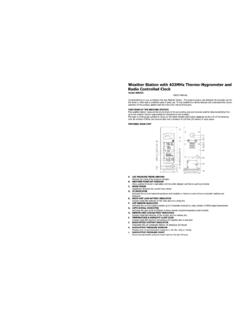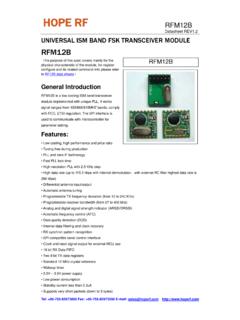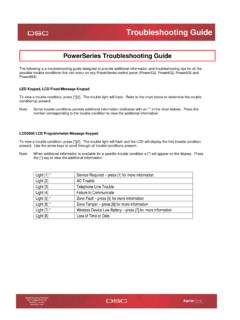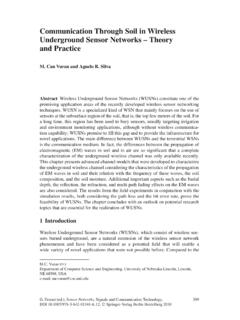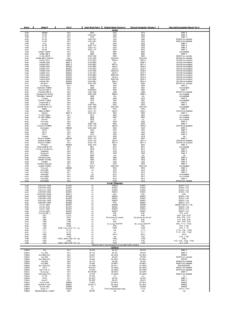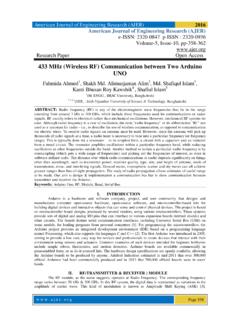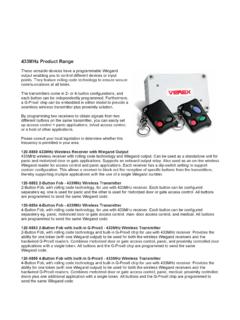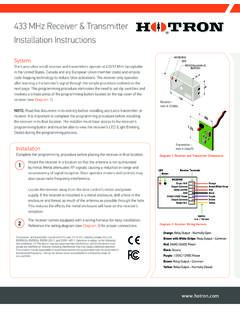Transcription of EzUHF R/C Control System
1 ImmersionRC | EzUHF R/C Control System 1 EzUHF R/C Control System Overview & Operatin g Instruction s Nov 2010, fo r Firm ware v1. 18 ImmersionRC | EzUHF R/C Control System 2 Table of Contents Overview .. 3 Features/Specifications .. 3 Security .. 4 Radio Licensing .. 4 EzUHF Transmitter .. 4 Powering the 4 Binding .. 5 Failsafe .. 6 Power Level Control .. 6 Range Testing .. 6 Transmitter Compatibility .. 7 S-Video pin-out: .. 7 PPM Input & Head-Tracker input pin-out: .. 7 Futaba (square) to EzUHF cable: .. 8 Multiplex (DIN) to EzUHF (Mini-DIN) cable: .. 9 Cabling the TrackR2 to the EzUHF Transmitter: .. 10 EzUHF Receivers .. 11 EzUHF Receiver, 8 channel version, Connections .. 12 Powering the Rx when using high-powered servos .. 12 Receiver antenna configuration .. 13 Driver/Software Installation on a PC.
2 13 EzUHF -> EzOSD link .. 13 Antenna Selection .. 15 Diamond SRH771 .. 15 Active Robots 433 MHz Straight .. 16 Active Robots 433 MHz R/A .. 16 Antenna extension cables .. 16 IMPORTANT: Known Sources of Interference .. 18 Appendix A: Binding multiple transmitters to a single receiver .. 19 Appendix B: Diagnostics .. 20 ImmersionRC | EzUHF R/C Control System 3 Overview The EzUHF R/C Control System is a reliable R/C Control uplink for FPV and UAV pilots who desire a robust Control System for safe Control at longer distances. It was designed with the FPV/UAV pilot in mind, the only such System with a dedicated head-tracker port, ensuring compatibility with a wide range of radios. An Aux Ctrl port is available to connect to a Control board , for in-flight UAV configuration without sacrificing valuable Control channels.
3 Features/Specifications Reliable FHSS Link (Frequency Hopping, Spread Spectrum) 433 MHz/70cm Ham band operation Options for 431-433 MHz, 433-435 MHz, 435-437 MHz. Spectrally clean GFSK modulation 600mW (~28dBm) output power, with 200mW low-power mode Direct head-tracker input, adding head-tracker compatibility to most radios Power switch, boost power when at long range (optionally drive from unused Control on the R/C Tx) Standard SMA antenna connector, compatibility with 433 MHz/70cm Ham-band antennas Flexible buffered, AC-coupled, PPM input, ensures compatibility with thru PPM levels Standard USB port (Mini-A) for firmware upgrades, and System configuration Single pushbutton learning of failsafe positions Binding function, which allows binding Single Tx->Rx, Multi Tx->Rx, and Single Tx->Multi Rx Mates with 8 channel, and 4 channel EzUHF receivers Spectrum analyzer built into EzUHF receivers, to aid in debugging RF interference Power sourced directly from the R/C Tx (Futaba), or optional DC power jack Built in receiver, for future expansion Custom extruded brushed aluminum enclosure Dimensions 85 x 74 x 23mm 118g Power Requirements: 9-12v DC 250 mA @ 12v, in 600mW mode, 85mA @ 12v, in 200mW mode ImmersionRC | EzUHF R/C Control System 4 Security The ImmersionRC team does not promote reckless long-range flight, where property and/or lives are put at risk.
4 This R/C Control System was brought to the market for use by responsible end-users, who are aware of, and comply with, local legislation regarding FPV/UAV flight. ImmersionRC accepts no responsibility for property damage, parts damage, model damage, or personal injury due to the misuse of the EzUHF , or any other ImmersionRC product. Radio Licensing The EzUHF R/C Control System transmits on radio frequencies which may require a license for use. The specific band of frequencies is firmware-dependent, and in some cases may be tailored to meet a retailer/distributor s requirements. The default band used is 433-435 MHz, which falls in the 70cm Amateur Radio band. Because of this, this product requires an Amateur radio (or similar) license to use in most parts of the world. Please check your local legislation before using this product!
5 EzUHF Transmitter Powering the transmitter The EzUHF transmitter has two flexible power options. Both of which may be used for additional redundancy: 1) Power supplied via the 4-pin mini-din connector. In the case where the transmitter is connected to a futaba radio, with , or 3s Lipo power source, this is the preferred method of powering the transmitter. 2) Power supplied via the DC power jack. In cases where the R/C transmitter either doesn t provide power via its trainer connector, or when a lower voltage is available (2s radios for example), it is preferred to power the EzUHF via the DC power jack. The power jack is center-pin positive, 2mm internal pin, outer diameter. A suitable plug is Mouser #502-S760BK NOTE: The EzUHF transmitter may safely be powered via both connectors simultaneously, even if two different voltages are presented.
6 ImmersionRC | EzUHF R/C Control System 5 As an example: Take the case of a R/C transmitter which uses a 2s LiPo pack. The EzUHF will emit slightly less power than specified (approx. 25dBm on 8v, vs. around 29dBm on ) when powered this way. In most cases this power difference is insignificant, for buzzing around the local flying field, this is a very reasonable power level. If full power is desired in this case, a 3s LiPo pack (or equivalent) can safely be connected to the DC Power jack, providing both higher power, and redundancy (no power will be consumed from the R/C transmitter s battery until the external pack is either drained, or removed). Binding Each EzUHF Transmitter and receiver must be bound together, before they may be used, as is the case with just about all of the systems on the market today.
7 The binding process teaches the receiver several pieces of information: 1) The transmitter s unique ID, and therefore its pseudo random hopping sequence 2) The precise frequency difference between the transmitter and receiver (caused by crystal tolerance) 3) The precise frame-rate emitted by the R/C Tx Note that point 3 does mean that rebinding is required if the EzUHF transmitter is switched between different R/C transmitters, especially those with different frame rates. For more advanced binding, see Appendix A: Binding multiple transmitters to a single receiver. The binding procedure is as follows: 1) Connect suitable antennas to both the EzUHF Tx, and Rx and place them within 1m of each other 2) Connect the EzUHF Tx to the R/C Transmitter, switch to low power mode, hold down the pushbutton, and turn on the radio.
8 3) As soon as a periodic beeping starts, let go of the button. 4) Apply power to the receiver, and within 10 seconds, hold down the binding button on the receiver. After < 1 second the LED should extinguish, and shortly after, it should flash 3 times, indicating binding success. If instead, the LED flashes 6, or 10 times, quite quickly, then binding failed, and must be re-attempted. NOTE!: The Bind switch on the 8 channel dual board receiver is accessed between the two boards, from the hole beside the servo connectors (it is not hidden under the BIND text on the label). 5) Power down the Tx, and Rx. Binding is complete. NOTE: The 10 second limit on the receiver ensures that the receiver can never enter binding mode accidentally during flight, if its button is accidentally pressed. ImmersionRC | EzUHF R/C Control System 6 See the advanced section, on how to bind multiple transmitters to a single receiver.
9 Failsafe If, for any reason, the UHF link is broken, the receiver will wait for approximately 1 second for the link to be restored, and then will enter failsafe mode. The failsafe servo positions are programmed using the button on the transmitter. To set this up, two phases are recommended. 1) With the plane on the ground, and servo positions neutral, throttle cut, hold down the transmitter s bind/failsafe button until the transmitter beeps. This will set a reasonable default failsafe ready for the first flight 2) With the plane in flight, set the controls in a suitable position for the failsafe, and re-program the failsafe. In most cases, suitable position means throttle cut, and a gentle turn radius, to let the plane circle gently until it lands, but of course every application is a little different.
10 Power Level Control The toggle-switch on the top of the EzUHF Tx is used to switch between high and low power modes. Even if full feedback of uplink status is available on the EzOSD display, it is highly recommended to fly in low-power mode most of the time, switching to high-power mode if required. The difference in power levels between the two modes is approximately 6dB, which corresponds to a factor of 2 in range, ensuring plenty of margin. Range Testing Before any flight it is highly recommended to perform a range test on the ground. For this, use at minimum the low-power mode, or more ideally, attenuate the transmitter output using an SMA attenuator for the range test (NOTE: Do not forget to remove the attenuators before the flight!!!!). A 20dB SMA attenuator, easily sourced on Ebay, is a good choice for this.

